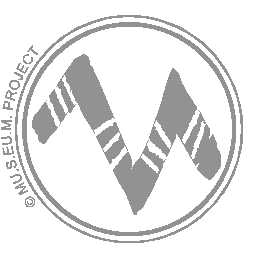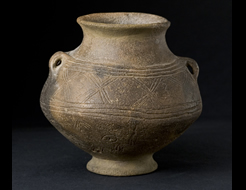|
||||||||||||||||||||||||||||||||
|
|
Museum of: Budapest | |||||||||||||||||||||||||||||||
| Name of the artefact: Vessel with symbolic representation | ||||||||||||||||||||||||||||||||
|
The vessel with decorated suspension handle and round
foot was found on a low hillside overlooking the Danube plains during
building operations. |
||||||||||||||||||||||||||||||||
|
WHERE IS IT AND MAIN
CHARACTERISTICS |
STATE |
|||||||||||||||||||||||||||||||
|
Department: |
Department of Prehistoric and Migration
Period |
Preservation: |
Very good | |||||||||||||||||||||||||||||
|
Inventory number: |
BTM 83.1.1. |
Restauration: |
Restored | |||||||||||||||||||||||||||||
|
Name of the artefact: |
Vessel with symbolic
representation |
Completeness: |
Complete | |||||||||||||||||||||||||||||
|
Object type: |
Vessel/Anphora |
|||||||||||||||||||||||||||||||
|
Material: |
Clay |
|||||||||||||||||||||||||||||||
|
Methof of manufacture: |
Hand made |
|||||||||||||||||||||||||||||||
|
Decoration
type: |
Incision |
|||||||||||||||||||||||||||||||
|
Distinctive mark: |
Depiction of conventionalized human
figures |
|||||||||||||||||||||||||||||||
|
DIMENSIONS |
PERIOD OF USE |
|||||||||||||||||||||||||||||||
|
Length (mm): |
- |
Epoque: |
Early Bronze Age |
|||||||||||||||||||||||||||||
|
Heigth
(mm): |
132 |
Culture: |
Nagyrév culture |
|||||||||||||||||||||||||||||
|
Diameter
(mm): |
90 |
Period: |
Early Bronze Age 3.a |
|||||||||||||||||||||||||||||
|
Width (mm): |
- |
Face: |
Younger |
|||||||||||||||||||||||||||||
|
Thickness (mm): |
- |
Absolute chronology: |
2200-1900 BC |
|||||||||||||||||||||||||||||
|
Weight
(g): |
- |
|||||||||||||||||||||||||||||||
DISCOVERY |
||||||||||||||||||||||||||||||||
|
Date: |
1982 |
Country: |
Hungary |
|||||||||||||||||||||||||||||
|
District: |
Budapest, XI |
Town hall affiliation: |
- |
|||||||||||||||||||||||||||||
|
Village: |
- |
Discovery findspot: |
Budapest, Pannonhalmi út |
|||||||||||||||||||||||||||||
|
Condition of discovery: |
Archaeological excavation |
Discovery type: |
Grave |
|||||||||||||||||||||||||||||
|
ANALYSES – DETERMINATIONS |
FILLED IN BY |
|||||||||||||||||||||||||||||||
|
Type: |
- |
Name: |
Anna Endrődi |
|||||||||||||||||||||||||||||
|
Laboratory: |
- |
Institution: |
Budapest History Museum |
|||||||||||||||||||||||||||||
|
No./Code: |
- |
Date: |
2005 |
|||||||||||||||||||||||||||||
|
DEEPENINGS |
||||||||||||||||||||||||||||||||
|
Morphology of the object: |
||||||||||||||||||||||||||||||||
|
Vessel with decorated suspension handle and round foot,
having broken off already in prehistoric times. The two horizontally
opening short strap handles sit upon the shoulders of the pottery facing
each other, with slant ridges fitting close to the body of the vessel at
their bases. |
||||||||||||||||||||||||||||||||
|
Decoration: |
||||||||||||||||||||||||||||||||
|
The decoration of the pottery is incised, which can be
seen in two planes, the patterns and scene repeated twice. The main motif
can be seen in the lower register – under the 3 incised lines running
parallel with each other from beneath the handle, where the decoration is
turned upside-down. In the focal point of the scene stands a large
stylized human figure with upraised arms; from his arms incised zigzag
lines reach both ways. Beside the human figure one larger and two
concentric circles can be seen with lentiform decorations inside, on its
right-hand side in the centre of a smaller concentric circle is a deeply
punched dot. On the right and left-hand side of the figure are three and
two incised parallels, respectively, which indicate the smaller incomplete
figures with raised arms (in adoration). Beside them trees are represented
in threefold V-shapes. The same scenes and symbols are repeated on the
opposite side, only in smaller scale and with less emphasis. |
||||||||||||||||||||||||||||||||
|
Inscription: |
||||||||||||||||||||||||||||||||
|
- |
||||||||||||||||||||||||||||||||
|
Analogies: |
||||||||||||||||||||||||||||||||
|
Known from the Nagyrév and Maros cultures. Some
Hungarian sites are: Tószeg, Nagyrév, Tiszaug-Kéménytető, Dévaványa,
Dunaújváros, Tököl, Csepel-Háros, etc.; a Serbian site is Mokrin. |
||||||||||||||||||||||||||||||||
|
Interpretation: |
||||||||||||||||||||||||||||||||
|
The large, complete human figure could be a
supernatural being. The zigzag lines represent water. The larger double
circle symbolizes the sun; while the smaller circle the moon. The smaller
stylized, incomplete human figures and the threefold V-shaped trees
portray the surrounding natural environment. The double portrayal of the
scene, and one of them being upside down, could have had a strict role and
meaning. The upper half also contains motifs (X-signs, incomplete human
figures) with symbolic meaning that fall into the lower half of the scene,
according to the viewpoint. This is a possible representation of a
creation myth: the enlarged and complete figure, with upraised arms in
adoration, lets fall water invigorating all that is below. Perhaps the
separation of water and land is also portrayed, the creation of the Sun
and Moon, and the incomplete humans and trees grow out of the ground by
the power of this supernatural being. The incised motifs of this
decoration give perhaps the fullest example of the religious symbolics of
the Nagyrév culture, being the first multi-detailed cosmological
representation to come to light. |
||||||||||||||||||||||||||||||||
|
Bibliography: |
||||||||||||||||||||||||||||||||
|
Schreiber, Rózsa: Szimbolikus ábrázolások korabronzkori
edényeken. (Symbolische darstellungen an frühbronzezeitlichen Gefässen)
Archaeológiai Értesítő 111. 1984. 3-28. Kalicz-Schreiber, Rózsa: Symbolic
Representation on Early Bronze Age Vessels. Indo-European Studies 18.
1990. 59-107. |
||||||||||||||||||||||||||||||||

